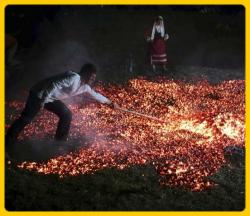|
| Nestinarstvo or Bulgarian fire-dancing |
|
|
 Similar to many other pagan rituals, the practice of nestinarstvo, a barefooted dance on smoldering embers, has to do with a big Christian holiday. On May 21 the Orthodox tradition pays honor to the spiritual activities of Saints Constantine and Helena. On the same day, people from a handful of villages in the southeast of Bulgaria perform an ancient dance on smoldering embers. In the year 2009, the UNSCO intergovernmental committee on world heritage entered Bulgaria’s nestinarstvo on the list of the organization. Being preserved and handed down from one generation to another, this thousand-year old ritual is performed in our lands to the present day. Stay with us to learn more about this enchanting tradition.
Similar to many other pagan rituals, the practice of nestinarstvo, a barefooted dance on smoldering embers, has to do with a big Christian holiday. On May 21 the Orthodox tradition pays honor to the spiritual activities of Saints Constantine and Helena. On the same day, people from a handful of villages in the southeast of Bulgaria perform an ancient dance on smoldering embers. In the year 2009, the UNSCO intergovernmental committee on world heritage entered Bulgaria’s nestinarstvo on the list of the organization. Being preserved and handed down from one generation to another, this thousand-year old ritual is performed in our lands to the present day. Stay with us to learn more about this enchanting tradition.
Emperor Constantine the Great remained in history for officially acknowledging Christianity as equal to the other religions in the Roman Empire. Irrespective of the fact that Bulgarians relate nestinarstvo to Saints Constantine and Helena Day, the Orthodox Church has never been at ease with that. The people who observed the ritual were persecuted up until the beginning of the 20 century. In a sense, that limited people to follow this tradition.
The fire dancing survived in the Strandzha villages of Kosti and Brodilovo. According to the locals, it was from there that nestinarstvo spread to other villages in the region. The cult of fire and dancing on smoldering embers was known by ancient peoples like the Hellenes, Romans, Hindus, Chinese, Persians and many others. Lighting fire was believed to protect people, Nature and even the Sun from evil forces. Fire is also believed to increase the Sun’s divine power. The people who perform the fire dance need to be clean, both physically and spiritually. According to folk wisdom, the fire challenge opens a door to the other world, and fire dancers are bestowed with the gift to foretell the future. The dancing on smoldering embers is always accompanied by a bagpipe and a kettle drum. The sounds of these instruments are believed to play an important part in the ritual’s enchanting atmosphere. The kettle drum is kept in a village’s church for a year and is brought to the fire dancing ground especially for the occasion.
Some researchers claim that the word nestinari (fire dancers) comes from a Bulgarian word meaning a skillful person. Nestinarstvo is also related to the Greek words for fasting and fire. As is usually the case with folklore practices, nestinarstvo is passed down from one generation to another. It is usually the head fire dancer who chooses his successor. When the former can feel that his life is coming to an end, or when he can dance no more, he gathers all the fire dancers in the village. In their presence, he chooses a successor, most often his son, and in case he has not got a son, he hands the craft down to his daughter. It was believed that passing down the skill from a father to a child was the only way to preserve the ability to predict the future.
http://bnr.bg |
| Friday, Jun 05, 2015 |
|
|
|
|
| » RENTALS |

|
|
|
| Commercial |
€ 770 |
|
| Location: |
Veliko Tarnovo |
|
|

|